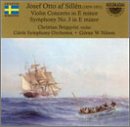| All Artists: Josef Otto af Sillen, Gavleborg Symphony Orchestra Title: Josef Otto af SillÚn: Violin Concerto in E minor; Symphony No. 3 Members Wishing: 0 Total Copies: 0 Label: Sterling [Qualiton] Release Date: 3/26/2002 Album Type: Import Genre: Classical Style: Number of Discs: 1 SwapaCD Credits: 1 UPCs: 675754492427, 7393338104421 |
Search - Josef Otto af Sillen, Gavleborg Symphony Orchestra :: Josef Otto af SillÚn: Violin Concerto in E minor; Symphony No. 3
 | Josef Otto af Sillen, Gavleborg Symphony Orchestra Josef Otto af SillÚn: Violin Concerto in E minor; Symphony No. 3 Genre: Classical
|
Larger Image |
CD Details |
CD ReviewsSurpirsingly effective late romantic fare Larry VanDeSande | Mason, Michigan United States | 04/15/2009 (4 out of 5 stars) "I've heard a lot of music by composers I never heard of, and I've heard a lot of music by composers I didn't know whose names were a problem for me to pronounce. But I've never heard music by a composer whose name I couldn't figure out -- until I purchased this compact disk.
Josef Otto af Sill`en (1859-1951) was a late romantic Swedish composer, born not far from Stockholm. He was head of the New Philaharmonic Society in that country and compoased at least five symphonies. Because the notes call him Josef af Sill`en, my assessment is he was Joseph from the Otto family that lived near Sill`en. Since I know nothing about Scandinavian language, I could be all wet on this. I don't know his surname so I'll call him Josef. Here he is represented by his Violin Concerto in E minor and his Symphony No. 3, again in E minor. The concerto is a robust late romantic work that reminded me immediately of the violin concerto of Max Bruch. Its date of composition is apparently unknown; the notes say it was premiered in the 1920s. It is constructed in the classical three movements, the third being a rondo, but it is late romantic emotionlly and far distant from anything Mozart ever composed in this format. I heard nothing too original in it while it pleased me as an unknown romantic concerto of some worthiness. It is played by Swede Christian Berqvist. The Symphony No. 3 is another matter. Here is a late romantic edifice of mostly sound construction that uses almost every instrument in the orchestra in a solo role somewhere. When the concerto closes, the symphony begins almost like it is the fourth movement of the concerto. Soon it begins to show its individuality, first with some effervescent Elgarian steppes, next with Wagnerian chromatics and occasional operatic sweep. The near-9 minutes second movement, labeled Andante, is the heart of the piece. Here the composer is at his most inspired, both compositionally and emotionally. A Rachmaninoff-like theme gives way to rising chromatics and a brass chorale. A later sour flute solo intercedes, and returns again later (better played, thankfully) before a clarinet flows to development. The Andante closes with a majestic romantic arc that leads to pounding timpani and brass. The third movement, Allegretto, starts with a Tchaikovskyan statement that goes on for 20 bars with a tambourine adding spice to the dotted rhythm before more romantic swells close the movement. A weakly-constructed final movement -- Moderato-Allegro vivace - begins with a tragic minor key theme followed by a skittish Dvoarkian section in the exposition that transfers to Wagnerian development, at which point the symphony just ends, as if the composer tired of writing this piece. A weak ending aside, this is a pretty good slice of late romantic fare from a composer that will be a mystery to most. It was recorded at Sweden's Gavle Concert Hall just after 9/11, meaning its been around almost a decade and is still leading a low-profile existence on the adventurous Sterling label. Goran Wilson and the Gavle Symphony Orchestra do well in the music although a better conductor and orchestra could find more in the music temperamentally. I heard sections that could be interpreted more Brucknerian while others could resonate with a bit more drama from the podium. While maybe not the ideal recording of this music, it's a good start and an interesting concert for anyone looking for something out of the way from the late romantic period or early 20th cenutry." |

 Track Listings (7) - Disc #1
Track Listings (7) - Disc #1